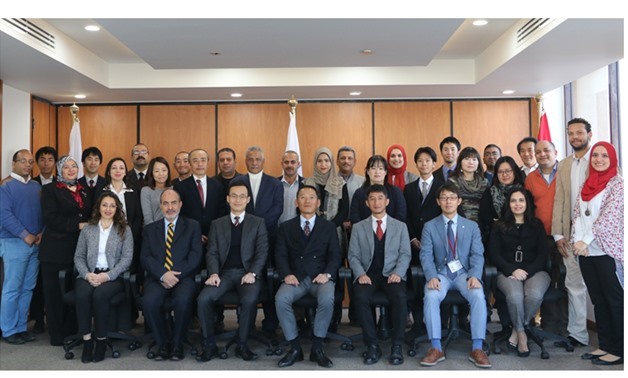
Members of JICA office in Egypt - Press Photo
CAIRO - 14 January 2018: apan’s economic cooperation with Egypt started in the 1950s, but saw a boost in economic ties with the establishment of the Japan International Cooperation Agency (JICA) in 1977. Providing low-interest, long term
and concessional loans to developing countries, JICA has since then funded various
projects in Egypt.
In 2017 alone, JICA has provided ¥684.8 billion ($6.05 billion) in loans to Egypt, in addition to ¥129.6 billion in grants and financial assistance for economic and social development. The agency also provided an additional ¥76.05 billion ($675.6
million) in technical cooperation and training programs. Just last month, JICA gave Egypt a ¥993 million ($8.8 million) grant to supply education and research devices for the Egypt-Japan University of Science and Technology (E-JUST).
Business Today Egypt sits down with the chief representative of JICA Egypt Office Teruyuki Ito to discuss the agency’s work in the region in addition to its latest projects.
What are the main fields of cooperation between JICA and Egypt?
We are working through three main pillars, the first of which is inclusive and sustainable growth, which includes electricity, transportation, tourism development and private sector development. The second pillar is poverty reduction and enhancement
of standard of living, which includes irrigation and rural development and basic social service.
Meanwhile, the third pillar is about human resource development and improvement of the public sector, including education and public sector empowerment.
Tell us more about JICA’s role in the Grand Egyptian Museum and why your agency decided to provide their support for the project. The construction is ongoing on the Grand Egyptian Museum (GEM) and we are expecting better progress. For the past eight years, JICA has provided projects for human resources development at the GEM as it dispatched more than 180 instructors to the project to deliver over 100 training programs.
The programs were in the fields of conservation and science, including 24 subjects, with more than 2,250 participants. Japan is providing support to the GEM because the Egyptian Museum of Cairo was built in 1902 and it has been aging and dilapidated for years. In light of supporting tourism development in Egypt, the government of Japan approved a loan of $300 million for the project in 2006 and another worth $460 million in October 2016. So far, the Egyptian government constructed the Conservation Center
in 2010 and it started operations in 2011.
The GEM is expected to include 100,000 artifacts, of which 50,000 will be exhibited including the treasures of Tutankhamun.
In addition to the GEM, JICA is funding several other projects, when is the expected repayment deadline?
We don’t have any doubts about the capability of Egypt to repay the loan from the generated revenues and resources. With the current economic reform measures undertaken by the government, the macro situation is getting better.
JICA is focusing as well on the energy sector, especially wind power plants. What are the latest updates in this regard?
JICA is funding two wind power projects, Zaafarana and Gulf of El Zayt in the Red Sea governorate. Zaafarana plant is already completed, while the Gulf of El Zayt is almost completed. We are expecting the official ceremony this year.
We’ve heard that JICA is implementing programs for health development in public sector hospitals. Can you tell us more information about this?
JICA is adopting the 5-S Kaizen health development project. We have started pilot phase in five or six hospitals, where we identified ways this project can be applicable in Egypt. After the pilot phase, we can study expanding to more hospitals. This project
aims to overcome challenges facing improving quality of health services and health insurance in the country. We will try to harmonize and connect what we are doing with Egypt’s needs.
As you are focusing on tourism development, are you considering funding airport expansions like the Borg El Arab Airport expansion project?
Expanding airports are important, not only for tourism, but also for transport. Borg El Arab Airport is a hub for so many people who are constantly travelling to Gulf countries. Also, we have worked on this project because the number of visitors to Alexandria is dramatically increasing.
With financial assistance from JICA, the Egyptian Airports Company has developed a new international passenger terminal complex at Borg El-Arab, which is 40 kilometers away from downtown Alexandria. The first phase is completed already and the second phase is underway as tender documents are being prepared.

Comments
Leave a Comment